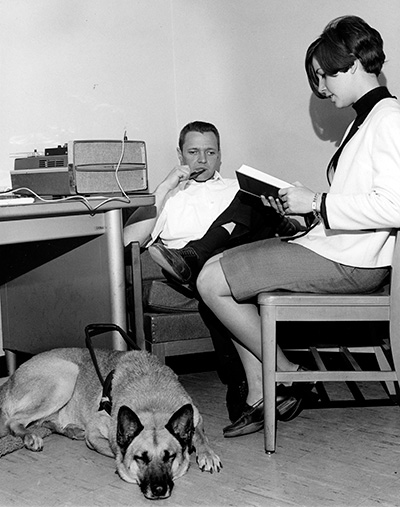Books & Materials
Below is a list of all books and materials from the Libraries and University Archives and Historical Collections featured in the exhibit. This is not a comprehensive list of all accessibility and disability studies books and materials the MSU Libraries has.
Main Library Books
- Ableist rhetoric: how we know, value, and see disability by James Cherney (2019)
- Accessible technology and the developing world by Michael Stein & Jonathan Lazar (2021)
- Adapted physical education and sport by Joseph P. Winnick & David L. Porretta
- Affirming disability : strengths-based portraits of culturally diverse families by Janet Story Sauer & Zachary Rossetti (2020)
- Crippled : austerity and the demonization of disabled people by Frances Ryan (2019)
- Demystifying disability : what to know, what to say, and how to be an ally by Emily Ladau (2021)
- Disabilities and the library : fostering equity for patrons and staff with differing abilities by Clayton A. Copeland (2023)
- Disability and human rights : global perspectives by Edurne Garcia Iriarte, Roy McConkey & Robbie Gilligan (2016)
- Disability and U.S. politics : participation, policy, and controversy by Dana Lee Baker (2017)
- Disability visibility : 17 first-person stories for today : adapted for young adults by Alice Wong (2020)
- Disabled futures : a framework for radical inclusion by Milo Woolf Obourn (2020)
- The guide to assisting students with disabilities : equal access in health science and professional education by Lisa M. Meeks & Neera R. Jain (2016)
- Introduction to American deaf culture by Thomas K. Holcomb (2013)
- Sign language in action by Jemina Napier & Lorraine Leeson (2016)
- Web accessibility project : development and testing best practices by Narayanan Palani (2023)
Children's Collection Books
The MSU Libraries’ children’s collection is focused especially on books related to diversity. This includes many books on accessibility and disabilities, some of which are found in this exhibit. These include books featuring characters with disabilities and books that are more accessible to readers with certain disabilities.
- The feelings book by Todd Parr (2005)
- This beach is loud! by Samantha Cotterill (2019)
- A kids book about autism by Justin P. Flood & David Flood (2020)
- Why Johnny doesn’t flap by Clay Morton and Gail Morton, illustrated by Alex Merry (2016)
- Talking is not my thing by Rose Robbins (2020)
- Little Red by Bethan Woollvin (2016)
- The Iron Trial by Holly Black and Cassandra Clare (2015)
- Lakelore by Anna-Marie McLemore (2022)
- (Don't) call me crazy: 33 voices start the conversation about mental health edited by Kelly Jensen (2018)
Special Collections Zines
- Sick of It: A Disability Inside/Outside project (2020)
- This zine is authored by a group of prison abolitionists and disabled activists who are “working to build connections between the free world disabled community and that behind bars.”
- “The 10 Principles of Disability Justice” is authored by Sins Invalid and succinctly expresses a credo that can inspire committed activists and those who are new to disability justice alike.
- Bending Spoons: a field guide to ableist microaggressions by Sabine Rear (2015)
- Chester Pierce, a Black Harvard-trained psychologist, coined the term microaggression in 1970 to specifically describe a type of racist behavior. The definition was quickly expanded by others to to describe “...the unintentional, unpremeditated degradation of members of any socially marginalized group (Paludi, Denmark, Denmark, & Paludi, 2010).”
- The title of this zine refers to “Spoon Theory,” introduced by Christine Miserandino in 2003. It is a metaphor that has been adopted by many in the disability community, particularly those living with chronic pain and fatigue.
University Archives & Historical Collections Photos & Memo
- Student using a braille map of the MSU campus, 1974 (MSU Archives # A010516)
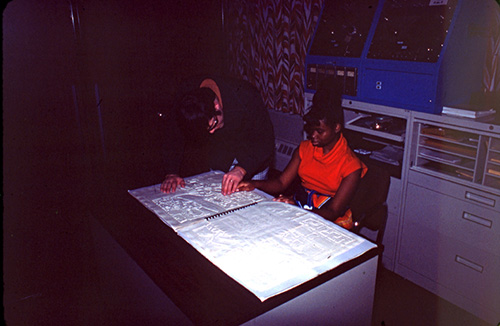
Tower Guard member reading to a visually impaired student, 1996
- The Tower Guard is a sophomore honor society. The group started in 1933 as the female honor society, the Q girls. In 1934, name changed name the Tower Guard. In 1977, Tower Guard also began inducting men as a result of Title IX. Throughout the years, one of the missions of the organization has been to support visually impaired students, and one way they do so is by reading course material. The photo shows a member of the Tower Guard reading to another student in 1996. (MSU Archives image #A010517)
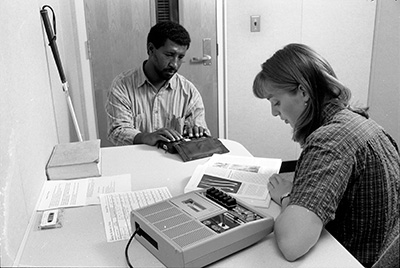
- Memo announcing the establishment of the Office of Handicapped Services in 1972 within the Office of Special Programs. Judy Taylor, who had been advocating for handicapper rights on campus, was hired as the coordinator. The Office of Special Programs had been created in 1971 providing services to disadvantaged students including handicapped students.
Handicapped Parking stickers introduced in Washington, D.C., 1973
- This photo show an example of MSU handicapped parking sport from 1976 (MSU Archives Image #A010518)
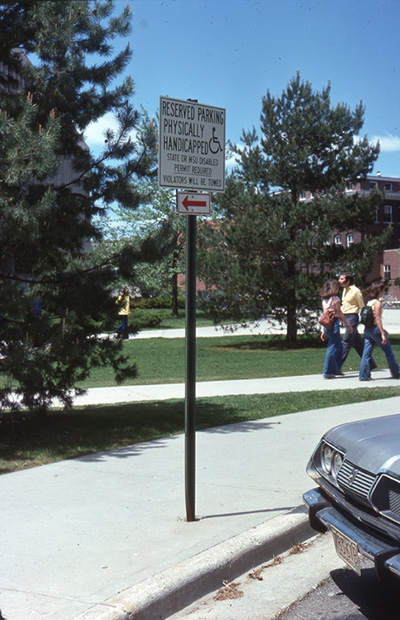
Curb Cuts Required in Michigan through Michigan’s Public Act 8 of 1973
- Michigan law required new sidewalks to have slopes where sidewalks meet streets. As a result MSU began installing the curb cuts. This photo shows a curb cut near Spartan Stadium. (MSU Archives image #A010519)
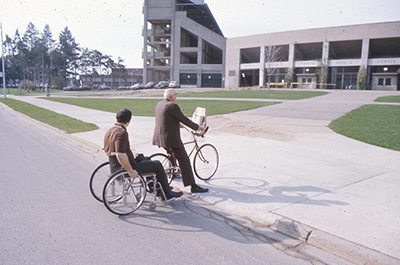
- MSU Removes Physical Barriers, 1977-1978:
- People in wheelchairs show frustration at being unable to navigate stairs on campus in 1977. MSU begins work on a plan for the systematic removal of physical barriers with the first report completed in the fall of 1978. The plan called for MSU to meet the requirements of Section 504 of the Rehabilitation Act of 1973. MSU’s plan included modification of entrances, installation or modification of elevators, making restrooms accessible. Prior to the plan MSU had improved access but there were still many physical barriers on campus. (MSU Archives image #A010520)
MSU Service Animal Policy Developed, 2003
- Although service animals have been on campus for decades, the Resource Center for Persons with Disabilities developed a Service Animal Policy outlining definitions, policies and requirements in 2003. This photograph shows a service dog for a visually impaired person. The handler is being read to by a member of the Tower Guard in 1967. (MSU Archives image # A010513
